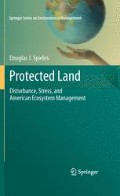Abstract
In Wonderful Life (1989), Stephen Jay Gould played a metaphorical game he called “replaying life’s tape.” In the game, you rewind the history of life on Earth to some point in the past, and then “let the tape run again and see if the repetition looks at all like the original.” He was writing about the evolution of various forms of life on Earth, not about the assembly of ecological communities, but the same game may be played with ecosystems. Rewind the tape a short time, perhaps a few million years, and press play. When the tape has returned to the present – assuming humans are still present – would we still be trying to preserve the oak savannas south of Lake Erie? Would we be managing ecosystems in eastern Kansas to favor big bluestem and Indian grass and to discourage woody species? And (though I would like to believe that the channelization of the Kissimmee would not happen in any other reality), would we still by trying to restore a mean annual dry season density of long-legged wading birds on the Kissimmee floodplain to greater than 30.6 birds/km2?
Access this chapter
Tax calculation will be finalised at checkout
Purchases are for personal use only
References
Barrett, G. W., and Rosenberg, R. 1981. Stress Effects on Natural Ecosystems. Chichester: Wiley.
Connell, J. 1978. Diversity in tropical rain forests and coral reefs. Science 199:1302–1310.
Costanza, R., and Mageau, M. 1999. What is a healthy ecosystem? Aquatic Ecology 33:105–115.
Denslow, J. S. 1985. Disturbance-mediated coexistence of species. In The Ecology of Natural Disturbance and Patch Dynamics, ed. Pickett, S., and White, P. S., pp. 307–323. Orlando: Academic Press.
Elmqvist, T., Folke, C., Nyström, M., Peterson, G., Bengtsson, J., Walker, B., and Norberg, J. 2003. Response diversity, ecosystem change, and resilience. Frontiers in Ecology and the Environment 1:488–494.
Egan, D., Howell, E. A., and The Society for Ecological Restoration International. 2005. The Historical Ecology Handbook: A Restorationist’s Guide to Reference Ecosystems. Washington: Island Press.
Grime, J. P. 2001. Plant Strategies, Vegetation Processes, and Ecosystem Properties. Chichester: Wiley.
Gould, S. J. 1989. Wonderful Life: The Burgess Shale and the Nature of History. New York: W. W. Norton.
Holland, A. 2000. Ecological integrity and the Darwinian paradigm. In Ecological Integrity: Integrating Environment, Conservation, and Health, ed. Pimentel, D., Westra, L., and Noss, R. F., pp. 45-60. Washington: Island Press.
Jørgensen, S., Bastianoni, S., Fath, B., and Muller, F. 2007. A New Ecology: Systems Perspective. Amsterdam: Elsevier Science.
Kolasa, J., and Rollo, C. D. 1991. Introduction: the heterogeneity of heterogeneity a glossary. In Ecological Heterogeneity, ed. Kolasa, J., Pickett, S. T., and Allen, T. F. H., pp. 1–23. New York: Springer.
Loucks, O. L. 1970. Evolution of diversity, efficiency, and community stability. Integrative and Comparative Biology 10:17–25.
Odum, E. P. 1969. The strategy of ecosystem development. Science 164:262–270.
Odum, E. P. 1985. Trends expected in stressed ecosystems. BioScience 35:419–422.
Odum, E. P., Finn, J., and Franz, E. 1979. Perturbation theory and the subsidy-stress gradient. BioScience 29:349–352.
Peterson, G., Allen, C., and Holling, C. 1998. Ecological resilience, biodiversity, and scale. Ecosystems 1:6–18.
Pickett, S., Kolasa, J., Armesto, J., and Collins, S. 1989. The ecological concept of disturbance and its expression at various hierarchical levels. Oikos 54:129–136.
Pickett, S., and White, P. S. 1985. The Ecology of Natural Disturbance and Patch Dynamics. Orlando: Academic Press.
Rapport, D., and Whitford, W. 1999. How ecosystems respond to stress. BioScience 49:193–203.
Rogers, P. 1996. Disturbance Ecology and Forest Management: A Review of the Literature. Forest Service Intermountain Research Station general technical report INT – GTR-336. Ogden: United States Department of Agriculture.
Rundel, P. W. 1999. Disturbance in Mediterranean-climate shrublands and woodlands. In Ecosystems of Disturbed Ground, ed. Walker, L. R., pp. 271–286. Amsterdam: Elsevier.
Sousa, W. 1984. Intertidal mosaics: patch size, propagule availability, and spatially variable patterns of succession. Ecology 65:1918–1935.
Walker, B. H., and Salt, D. 2006. Resilience Thinking: Sustaining Ecosystems and People in a Changing World. Washington: Island Press.
Walker, L. R., ed. 1999. Ecosystems of Disturbed Ground. Amsterdam: Elsevier.
Author information
Authors and Affiliations
Corresponding author
Rights and permissions
Copyright information
© 2010 Springer Science+Business Media, LLC
About this chapter
Cite this chapter
Spieles, D.J. (2010). Disturbance, Stress and Resilience. In: Protected Land. Springer Series on Environmental Management. Springer, New York, NY. https://doi.org/10.1007/978-1-4419-6813-5_4
Download citation
DOI: https://doi.org/10.1007/978-1-4419-6813-5_4
Published:
Publisher Name: Springer, New York, NY
Print ISBN: 978-1-4419-6812-8
Online ISBN: 978-1-4419-6813-5
eBook Packages: Earth and Environmental ScienceEarth and Environmental Science (R0)

